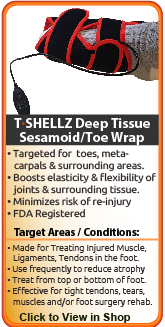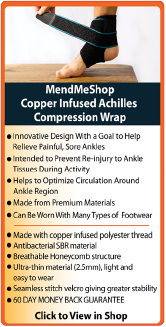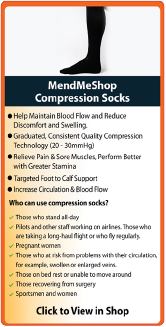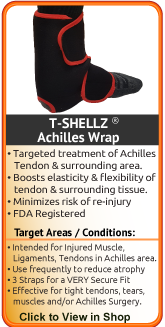Advanced Treatments for
Plantar Plate Tears
What Is A Plantar Plate Tear?
Your foot is a complex area of the body, it's small compared to the rest of your body but it's packed full of tendons, ligaments, muscles and bones. Each toe in your foot has a small fibrous band of tissue called a ligament that connects the foot bones to the toe bones. The plantar plate(s) are a special type of ligament that is super strong and flexible. These plantar plates' job is to help pull your toes down toward to the floor. The plate helps stabilize your toe from shifting side-to-side and maintains the toe in its correct position. Each foot contains four of these plantar plates, one for each toe except the big toe, which does not have a plantar ligament plate.
Symptoms Of A Plantar Plate Tear
If you are suffering from a plantar plate tear you may feel as if you're 'walking on the bones of your foot'. You could have pain beneath your 2nd (this is the most common area of pain), 3rd or 4th toes that gets worse with walking, jumping or running. You may have felt a tearing sensation when the injury originally happened. The toe could have dislocated and 'popped' back into place.
If you're suffering with a lot of pain you may develop a limp to avoid the pain and placing any weight on your foot. You may also notice swelling and redness on the top of you foot. If your plantar plate injury is severe you may have had bruising near or over the affected toe. If left untreated, your foot/toe will develop a toe deformity called 'hammer toe'.
You might be suffering from a Plantar Plate Tear if:
- You have sharp pain right under your second toe, in the ball of your foot.
- You feel a burning pain that shoots into the affected toe when walking or running.
- Your toe may appear to be out of alignment with the other toes.
- You have swelling and redness on the top of your foot.
- You may feel as if you are 'walking on the bones of your foot'.
If any of those statements are true for you or you're suffering from on-going pain under your toe(s) or at the front of your foot then you might have a "Plantar Plate Tear". It's an injury that's not commonly heard of - people are more likely to understand that they might have plantar fasciitis, tendonitis or some other injury in their foot.
Many people don't know that a plantar plate tear is a very real injury affecting the soft tissue and bone(s) in your toes. It can happen to anyone who regularly puts a lot of pressure on the front of their foot.
Plantar Plate Tears are one of those injuries that can really bring down the quality of your life. Anyone - young or old - can suffer from this injury, and if you're active this condition will keep you from doing the things you love to do. It will even start interrupting any of your normal daily tasks and make living life harder than it really needs to be.
Plantar Plate tears can happen to anyone, not just professional athletes. Right now, there are thousands of doctors and physical therapists dealing with patients that require a solution to treat their plantar plate tears fast and heal it (where possible). If you want to be proactive about properly addressing your plantar plate tear, speak to your doctor about adding to your treatment with AidYourTendon's system utilizing Circulatory Boost and cold.
Causes of Plantar Plate Tears
Acute injury: Plantar plate injury can come from:
- A sudden and excessive upward motion of the toe.
- Pushing too hard onto your toes when transitioning from a standing position to a run.
- Standing on your tiptoes and pushing upwards on your weight.
- Walking too much.
Chronic injury: This type of plantar plate injury has developed over time. The ligament suffers from micro-tears in the tissue and is stretched out. You may have had a sudden acute injury at first but left untreated and undiagnosed it has not healed and turned 'chronic'. The most common cause of chronic plantar plate tears is when your feet over-pronate or roll inward. It's very common for middle aged women to experience plantar plate tears as the foot is rolling inward when they walk. Over time a chronic injury may lead to a severely deformed toe that is locked out of normal position.
An untreated Plantar Plate Injury
Can Lead to a Secondary Injury or Foot / Toe Deformity
What Is Overcompensation Pain?
Long-term changes in your gait (the way you walk) - like shuffling or limping to reduce pain around your toes, can impact other areas of your body and possibly result in something called 'overcompensation pain'.
Everything in the human body is connected. A plantar plate injury can lead to other injuries over time if not treated properly. You might start limping or shuffling because of your injured foot and place more weight on your opposite, healthy foot. Limping your way around for a long period of time may lead to pain in the heel of your foot, knee, hip or lower back on your injured side because you are mis-aligning your entire leg. The goal is to prevent secondary injuries while letting your toes heal. If you are changing the way you walk - try keeping your foot straight and off to the side to compensate for the injury.
Any injury left untreated can lead to overcompensation pain. Dealing with the injury quickly and healing completely should be your main focus. Plantar plate healing takes time... You can speed up your body's natural healing with very simple steps - like using a Cold Compress or Ice Pack, rest and a TShellz Wrap®.
How Do I Diagnose a Plantar Plate Tear?
It's important to find out what's wrong with your foot. Plantar plate injuries are often misdiagnosed as they are similar to some other injuries that affect the foot. This is very true for those who are very active or enjoy running sports. When seeing your doctor they will discuss your medical history and examine your foot, heel and ankle for any deformities or inflammation (swelling, redness, heat, pain). They will also look at your flexibility, stability, and gait (the way you walk). Occasionally an x-ray of your foot will help rule out Metatarsal (toe) Stress Fractures. An MRI can be used to provide a complete and accurate diagnosis of any injury to the soft tissue (ligaments) in your toes. In some cases the doctor will request blood tests to rule out diseases or infections.
Do You Really have a Plantar Plate Tear?
Our feet are some of the most complicated joints in our bodies with 26 bones, 33 joints and more than 100 tendons, muscles and ligaments (reference: 1).
Toe pain can come from injuries to the soft tissue in the foot or to one of the many tiny small bones, some of the more common injuries being:
- Foot bursitis - Bursitis can occur in the toe joints, the side of the foot, the heel and around the ankle. As we walk, run or jump, the ground surface and the shoes we wear play an important role in how much trauma our feet experience. Every step can cause a small amount of damage to a particular area in the foot which can increase the risk of bursitis.
- Morton's neuroma - This condition usually causes burning pain in the ball of the foot that may radiate into the toes. The pain generally intensifies with activity or wearing shoes. You may sometimes feel that you are "walking on a marble," and you have persistent pain in the ball of your foot. You may also have numbness in the toes. Neuroma is often the misdiagnosis of plantar plate tears the two conditions have similar symptoms.
- Metatarsalgia - This condition can also cause pain in the ball of your foot, that area between your arch and the toes. Metatarsalgia is a common overuse injury, persistent stress can lead to chronic irritation and inflammation of the bone covering and surrounding tissues, such as ligaments and tendons.
- Sesamoiditis - The big toe has two very tiny bones embedded in tendon tissue in the ball of the foot. Any type of injury to the tendon tissue can cause irritation in and around the sesamoid bones. This condition can also cause pain in the ball of your foot, that big toe. Sesamoiditis is a common overuse injury, persistent stress can lead to chronic irritation.
- Plantar Fasciitis - Pain associated with plantar fasciitis normally starts as a dull ache and then progresses to a sharp, knife-like pain or constant throbbing feeling that is worse when you put weight on your foot. The most tender areas tend to be in the center of your heel and along the inside and bottom of your foot towards your toes, where your heel and arch meet.
- Turf toe - This can happen when the big toe joint is pushed beyond its' normal range (backwards or downwards). A 'pop' is felt at the moment the injury happens followed by sharp immediate pain. Symptoms include swelling in the foot, the entire big toe joint is affected and limits the motion in the toe.
- Pre-dislocation syndrome, crossover toe deformity and floating toe syndrome are terms related to a plantar plate tear or sprain.
How Do I Cure Plantar Plate Tear? -
What You Can Do!
We Have Advanced Treatment Tools to Help You
Speed Up Healing of Your Plantar Plate Tear!
The good news is that most plantar plate tears will heal with simple home conservative treatments and surgery is often not needed!
It's generally understood by doctors and surgeons, that surgery will introduce more scar tissue into the foot. This added scar tissue will be problematic, requiring visits to the clinic and conservative treatment options post-surgery. When it comes to a plantar plate tear, rupture, and bone fractures there's only a few surgical options for treatment - sutures are used to repair the torn tissue. This is why surgery is only performed as a last resort for chronic plantar plate injuries, complete rupture or a fractured metatarsal bone that won't heal with conservative treatment methods.
Some conservative treatment methods recommended include:
 - Rest - This is important for initial healing to reduce pain, swelling and inflammation in the early stage of your tendon injury. Too much rest can also be harmful as joint immobility can actually cause stiffening, overcompensation and atrophy (shortening & wasting away of soft tissue). This is why rest should be used when reducing initial pain and swelling, but should not be considered for more long-term conservative treatment.
- Avoid Activities that Caused Your Injury - While resting your problematic joint, it's important to avoid activities that may have caused your injury in the first place and this definitely includes pretty much any type of sport or repetitive movements that might be undertaken when working. Continuing on with regular activities will not only make your injury worse, but trying to 'work around' your injury will eventually give rise to over-compensation injuries in other areas of your body.
- Use a Cold Compress or Ice Pack - Cold is very effective at reducing pain and inflammation - use at the onset of the injury and during flareups.
- Use a TShellz Wrap® (Circulatory Boost device) Once The Swelling is Down - You can use your own blood flow to maximize your rehabilitation, maintain healthy blood flow to your soft tissue, decrease recovery time, and reduce re-injury risk. Promoting blood flow to the injury using a warming treatment will help to minimize the growth of scar tissue and increase flexibility. This is why we recommend TShellz Wrap before undergoing activity - an increase in flexibility should help reduce risk of further injury while also assisting in the battle against atrophy.
- Avoid Over Compensating for your Injury on your "'Healthy' (Non-Injured) Side - Many people will start limping or carrying objects with their opposite arm to compensate for their tendon injury. Our bodies can adapt easily to any changes, including a tendonitis injury. This quick adaptation could mean that you're already compensating for your injury without even knowing it!
When you compensate for your injury by using your opposite ('healthy') arm, leg, shoulder, knee, foot, etc. - then you are putting more weight and pressure on that side of your body. In many cases, your dominant side was injured (if you're right-handed this would be your right side) so your weaker side is trying to pick up the slack! The pain, stiffness, swelling and inflammation you then get on your 'healthy' side is something referred to as 'over-compensation pain'. Over-compensating for your injury can lead to other injuries and so that's why over compensation should be avoided at all costs OR treated with the same conservative treatment methods as your tendon injury.
- PT - Surgery is usually the last resort. This means doctors or surgeons typically won't perform a surgery until they feel that their patient has put effort into treating their injury with conservative treatment methods. This includes 4 to 6 months of visits to a PT. If you haven't experienced any improvement in your condition during that time then surgery may be considered. Agressive PT approaches will focus on forced or manual manipulation - this means your PTs will be trying to move you past the point of comfort as they strive to increase range of motion and prevent further atrophy.
- Stretching - Stretching your joint in PT and at home will help you to regain your range of motion much faster than not stretching at all. Stretching in many ways is key maintaining good Range of Motion (ROM) in your joint, and stretching can be made much easier with use of a TShellz Wrap® before to warm up soft tissue, and a Cold Compress or Ice Pack treatment after to prevent any return of swelling and inflammation.
Foot Support Aids For Plantar Plate Tears
A cushioned athletic shoe with a wide toe-box may relieve pressure on you plantar plate injury. Taping the toe down or taping the toe to the neighbouring toes may help the condition from worsening.
- Wearing wide toe-box, cushioned athletic shoes gives your toes more room. Wearing a stiff-soled shoe like clogs or flat insoles that keep your toe straight, can help to reduce the pressure being placed on your plantar plate(s). For some people, a soft-soled shoe (like flip-flops) are even more comfortable and reduce the pain. If you've recently started wearing a new pair of shoes with a different type of arch support insole then this might even be the reason why you now have foot pain.
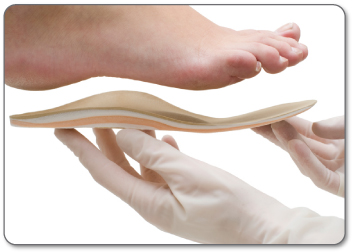 - Put Orthotics in Your Shoes - Use of any kind of orthotic or insert for added support in your shoe should always be done through the recommendation of your doctor. There are certain shapes of padded inserts / orthotics that are designed to relieve pressure on the plantar plate and keep your toes straight. You have to be careful with your choice of orthotics and may need to get some custom-made by your doctor because there's always a possibility that using the wrong orthotics will make your injury worse. Plantar metatarsal pad's may by be recommended by your doctor.
- Tape Your Toe - You can try taping or strapping your toe in a flexed position (bent down) to reduce any pressure placed on your plantar plate injury. Tapping also adds a slight degree of support for the tissue.
Use a Cold Compression Cold Compress or Ice Pack:
- 24 to 72 hours after your initial injury or when you first notice pain and swelling around your toes to stop tissue damage at the microscopic level, relieve pain, and decrease swelling.
- After exercise, workouts or activity of any kind to prevent re-injury of your toe.
- Before and after surgery during rehabilitation to control pre and post-surgery pain and swelling.
- Anytime you feel your plantar plate has made your foot tender, painful or you're having a flare-up of an old plantar plate injury.
- Anytime you have swelling, sharp throbbing pain or inflammation in your plantar plate or around your toes.
- Any other situation where you need to draw the pain and inflammation out of your foot.
Use a Circulatory Boost TShellz Wrap®:
- After swelling and inflammation have been reduced with cold compression.
- Before exercise or workouts to warm up your foot to prevent re-injury.
- Before and after surgery during rehabilitation to warm up your tissues before exercising or stretching.
- Anytime you feel the tissue in your foot has stiffened up, is tight and your mobility is reduced causing you more pain.
- Anytime you have sore or aching tissue in your injured toe.
- Any other situation where you need to increase blood flow to your plantar plate to relax your soft tissue, relieve pain, prevent re-injury and enhance flexibility of your tissue.
If you need to have surgery, talk to your doctor about using these same products for post-surgery recovery. You'll find them effective for reducing post-surgery inflammation, enhancing range of motion and minimizing the growth of scar tissue in your foot.
Plantar Plate Tear Surgery
It's generally understood by doctors and surgeons, that surgery will introduce more scar tissue into the plantar plate tissue. This added scar tissue will be problematic, requiring visits to the clinic and conservative treatment options post-surgery. If not dealt with properly, your toe could end up in worse condition than before the surgery! This is why surgery is only performed as a last resort.
If you and your doctor have decided that your injury is in a state of un-healing and conservative treatments have not worked to correct your plantar plate tear. There are two types of surgical procedures available to repair your plantar plate.
Surgery for a Chronic Plantar Plate Tear/Injury
Usually conservative treatment methods are all that's needed to treat a plantar plate tear. Surgery is only ever used if long-term conservative treatment methods don't work or if you've suffered from a plantar plate rupture, hammertoe or a deformity in your toes/foot. Conservative treatment options for plantar plate injury typically includes rest, icing of the injury, avoiding activities that cause or worsen the pain that you're feeling, wearing comfortable shoes that keep your toes straight and anti-inflammatory over-the-counter medication (reference: 1, 2, 3, 4, 5). However, sometimes Plantar Plate Surgery does happen.
 Surgery involving a correction to your bone will be performed if you suffer from a chronic plantar plate injury that has resulted in your toe raising up off the floor or pulling away and crossing over your other toe(s). In extreme cases you may now have hammertoe that needs to be corrected surgically. Surgery to correct the toe requires a transfer of tendon tissue called a 'flexor to extensor tendon transfer'.
This plantar plate repair is done with sutures to re-position your toe and a tiny amount of bone is removed (removal of this bone is called a 'Weil Osteotomy'). The shortening of the toe allows the surgeon to gain access to the plantar plate and decreases tension and forefoot pressure post-operatively. The goal of the surgery is to relieve pain at the bottom of your toe, re-align the toe and bring the toe back down toward the floor.
You may be fitted with a hard cast or a surgical shoe that you may have to wear for approximately 6 weeks. The amount of time you'll have to wear this cast depends on the amount of work the surgeon had to perform to fix your plantar plate and correct your toe. In most cases this is an 'out patient' surgery where you will arrive that morning and leave the same day as your surgery (no hospital stay is required).
During post-surgery recovery after-care is very important in order to keep the toe in the proper position while healing. Depending on the type of that you have job you may need to take at least one week off (especially if extensive standing, walking, climbing, etc is involved). Consistent cold compression is important during early recovery to reduce swelling, inflammation and naturally treat any pain. Your surgeon will schedule a follow-up visit 1 to 2 weeks after surgery to check your toe and the incision site. You may have a temporary cast or bandage removed if you were originally placed in one right after surgery and begin wearing a more permanent, hard, surgical cast. Another method your doctor may use is tapping your toe to reduce pressure. If your toe is taped, this tape will need to stay on for about 6 weeks.
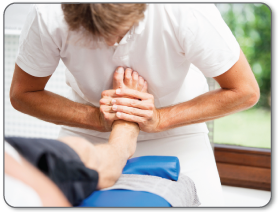 Around the 2nd or 3rd week of recovery, your surgeon will have you begin stretching and exercising your toes. Exercises may include crunches by picking up a marble with your toes. Transitioning back into regular shoes usually happens around 6 weeks, but this depends on how well you're healing. At this point you may begin to walk more normally and become less flat-footed. Your regular check-ups with your surgeon and your overall healing progress will be the guide. It may take up to 12 weeks for you to return to other normal activities - like walking briskly or jogging.
New Plantar Plate Surgical Technique
One of the new techniques of performing a plantar plate surgery involves the use of smaller tools and an incision site on the top of your foot. This new technique provides quicker recovery and less risk of postoperative problems than the traditional method we already mentioned. An incision at the top of the foot actually makes your recovery faster because it means you won't be stepping on your incision (in your cast or with the aid of crutches) while trying to recover.
You should always discuss the type of surgery your doctor plans to perform before you have your surgery. As with any surgery, there are many complications that can arise and so it's always important to discuss all possible complications with your surgeon to choose the correct path for your recovery.
Surgery isn't the end of your journey, it's merely the beginning long-term healing and recovery from your plantar plate injury.
Product Advisors are available 9:00 am to 5:00 pm Eastern Standard Time Monday to Friday.
Learn More About Tendon Injuries & TreatmentsI want to learn more about Post-Surgery Recovery I want to learn more about TShellz Wrap® Circulatory Boost I want to learn more about Ice & Heat: Which Is Better For Treatment? I want to learn more about Tendonitis Treatments I want to learn more about Tendonitis Surgery
FREE SHIPPING ON ALL PRODUCTS CURRENTLY ENABLED
60 DAY TRIAL PERIOD
During your recovery, you will probably have to modify and/or eliminate any activities that cause pain or discomfort at the location of your soft tissue injury until the pain and inflammation settle. The more diligent you are with your treatment and rehabilitation, the faster you will see successful results!
| 
